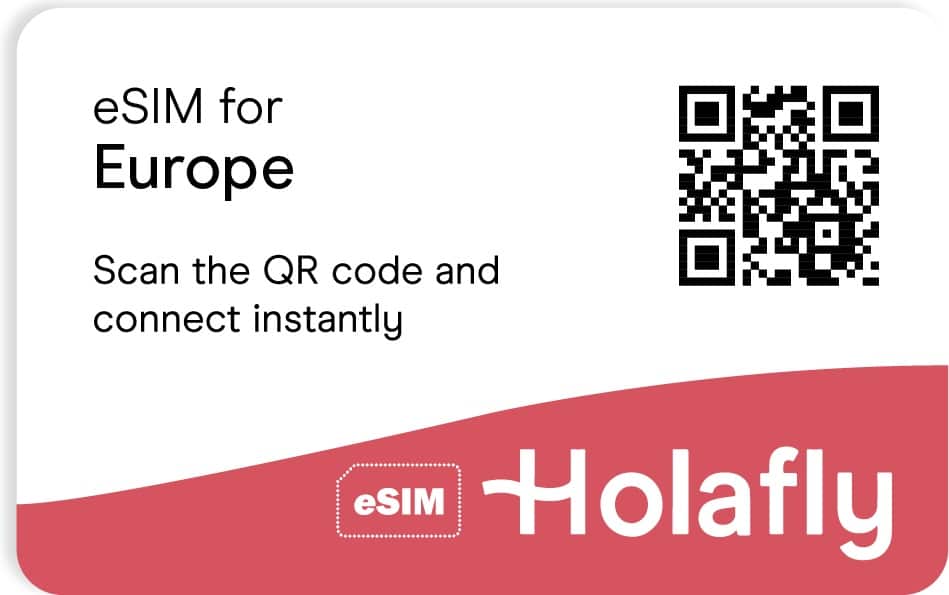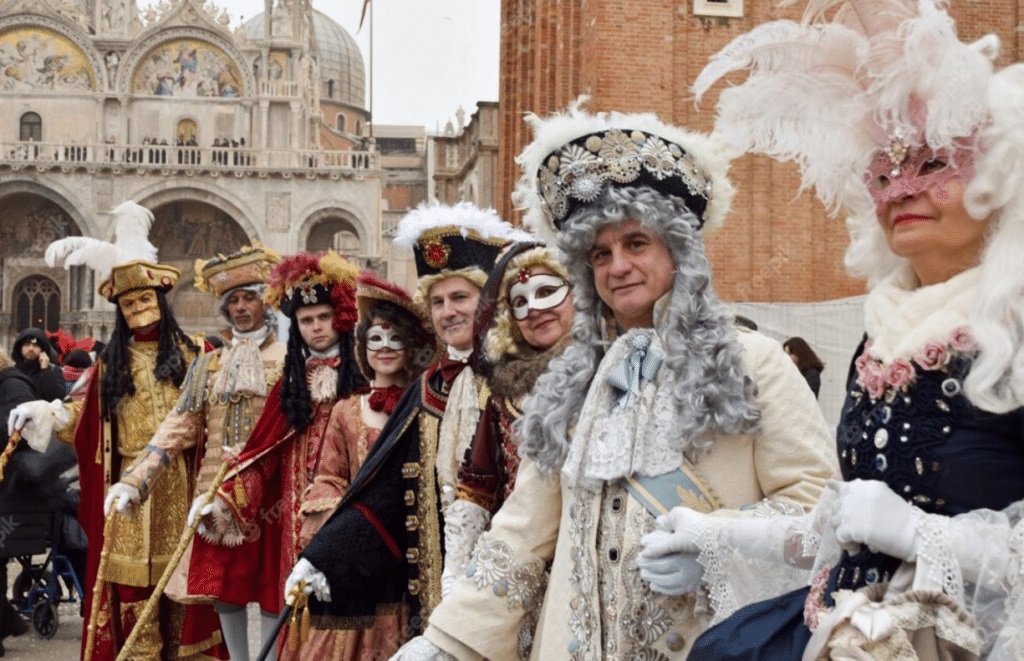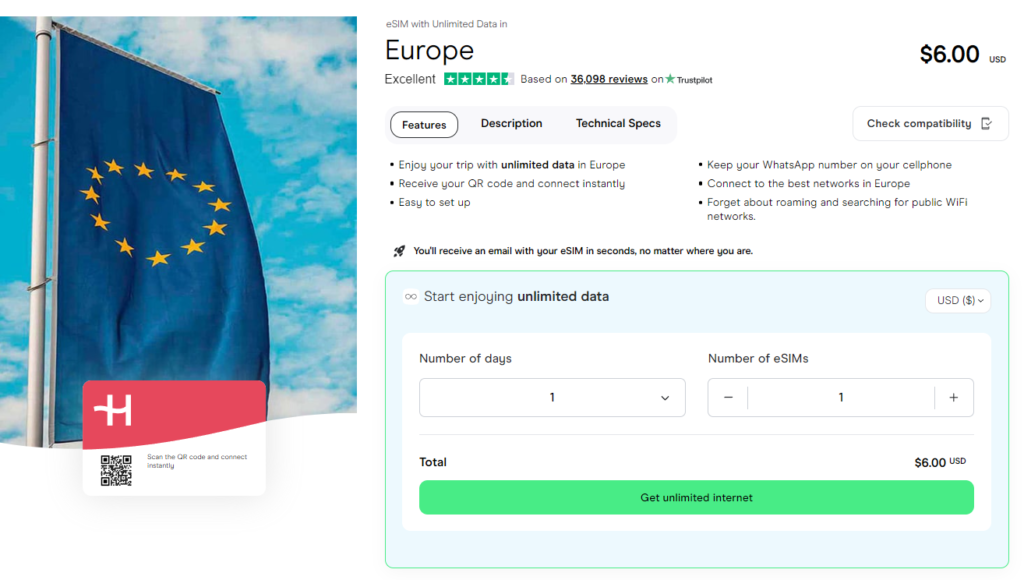Europe Travel Guide: Uncover the Top Destinations to Explore
Embark on a journey across the old continent with our Europe Travel Guide. Explore must-see destinations, exciting activities, and insider tips for budget-friendly adventures



 +1M
+1M
 Unlimited data
Limitless data plans in more than 170 destinations
Unlimited data
Limitless data plans in more than 170 destinations
Holafly saves you +30% compared to other roaming fees
Plans that may interest you
Embark on an unforgettable adventure with our meticulously crafted Travel Guide to Europe. After in-depth research and personal exploration, we present you with a comprehensive handbook. This guide includes interesting insights, optimal travel timings, transportation tips, and must-visit destinations.
Additionally, discover the charm of lively metropolises, enchanting villages, heavenly coastlines, and majestic Alpine peaks – Europe is a wealth of experiences just waiting for you! Get ready for a deep dive into the best tips that let you explore Europe without emptying your wallet, ensuring each moment is memorable.

Exploring Europe: Overview
Within the upcoming table, you’ll see information on the 50 official countries comprising the European continent, including details on their languages, currencies, and climate.
The climate data provided in the table reflects the minimum and maximum temperatures experienced during the winter and summer seasons.
| Country | Language | Currency | Climate |
| Albania | Albanian | Lek | 5°C to 27°C |
| Andorra | Catalan | Euro | 1°C to 30°C |
| Armenia | Armenian | Dram | 16°C to 29°C |
| Austria | German | Euro | – 0.6°C to 27°C |
| Azerbaijan | Azerbaijani | Azerbaijani manat | – 2.4°C to 27°C |
| Belarus | Russian, Belarusian | Belarusian ruble | -3.9°C to 17°C |
| Belgium | Dutch, French, German | Euro | 0.4°C to 24°C |
| Bosnia and Herzegovina | Bosnian, Croatian, Serbian | Bosnia and Herzegovina convertible mark | -0.4°C to 27°C |
| Bulgaria | Bulgarian | Lev | -0.4°C to 25°C |
| Croatia | Croatian | Euro | -0.1°C to 27.3°C |
| Cyprus | Greek, Turkish | Euro | 11.1°C to 31°C |
| Czech Republic | Czech | Czech koruna | -2.4°C to 23°C |
| Denmark | Danish, Faroese, Greenlandic | Danish krone | -0.4°C to 26°C |
| Estonia | Estonian | Euro | -7.3°C to 18°C |
| Finland | Finnish, Swedish | Euro | -8.3°C to 18°C |
| France | French | Euro | 2.3°C to 39°C |
| Georgia | Georgian | Lari | 4°C to 27°C |
| Germany | German | Euro | – 5°C to 32°C |
| Greece | Greek | Euro | 9.5°C to 27.4°C |
| Hungary | Hungarian | Hungarian forint | -2.5°C to 26°C |
| Iceland | Icelandic | Icelandic króna | -4.3°C to 17°C |
| Ireland | Irish, English | Euro | 4°C to 17°C |
| Italy | Italian | Euro | 3°C to 40°C |
| Latvia | Latvian | Euro | -3°C to 23°C |
| Liechtenstein | German | Swiss Franc | -0.7°C to 20°C |
| Lithuania | Lithuanian | Euro | -5.2°C to 19°C |
| Luxembourg | Luxembourgish, French, German | Euro | 0.2°C to 18°C |
| Malta | Maltese, English | Euro | 11°C to 35°C |
| Moldova | Romanian | Moldovan leu | -5.4°C to 26°C |
| Monaco | French | Euro | 8°C to 27°C |
| Montenegro | Montenegrin | Euro | 0.1°C to 25°C |
| Netherlands | Dutch | Euro | 2.2°C to 20°C |
| North Macedonia | Macedonian, Albanian | Macedonian denar | -1.2°C to 27°C |
| Norway | Norwegian | Norwegian krone | -4.9°C to 18°C |
| Poland | Polish | Zloty | -3.5°C to 29°C |
| Portugal | Portuguese | Euro | 10°C to 38°C |
| Romania | Romanian | Leu | -2.5°C to 23°C |
| Russia | Russian | Russian ruble | -16.3°C to 17°C |
| San Marino | Italian | Euro | 5.1°C to 25°C |
| Serbia | Serbian | Dinar | 12°C to 24°C |
| Slovakia | Slovak | Euro | -2.4°C to 23°C |
| Slovenia | Slovenian | Euro | -1.4°C to 25°C |
| Spain | Spanish, Catalan, Galician, Basque | Euro | 6.9°C to 38°C |
| Sweden | Swedish | Swedish krona | -1.2°C to 20°C |
| Switzerland | German, French, Italian, Romansh | Swiss Franc | -0.9°C to 19°C |
| Turkey | Turkish | Turkish lira | 0.3°C to 32°C |
| Ukraine | Ukrainian | Ukrainian hryvnia | -5.6°C to 25°C |
| United Kingdom | English, Welsh, Scottish, Irish | Pound sterling | 3.1°C to 22°C |
| Vatican City | Latin, Italian | Euro | 5.1°C to 24°C |
Please remember that weather conditions vary depending on your travel season and the specific region within the continent you choose to explore. Therefore, we recommend checking the weather forecast for each city before your trip. (You can refer to Meteored for up-to-date weather information.)
Additionally, understanding the time zone is crucial, as it differs across various regions and switches between standard and daylight saving time. Here’s a brief overview: Western Europe (WET) UTC±0, Central Europe (CET) UTC+1 and (CEST) UTC+2 during summer, Eastern Europe (EET) UTC+2 or (EEST) UTC+3, Kaliningrad European UTC+2, Moscow European UTC+3 (MSK, МСК).
You may be interested in Italy eSIM card plans for travel.
Key Considerations for Your European Journey
In preparation for your trip to Europe, it’s vital to consider aspects such as currency exchange, visa requirements, safety measures, health precautions, internet connectivity, and even local customs. So, to help you, we’ve compiled a summary of these essential points to enhance your stay.

Currency Exchange
Converting your currency into the local currency is an essential step, enabling you to cover your expenses in any European country. There are several methods for currency exchange, including exchange offices, banks, ATMs, and money transfers.
Our top recommendation is to opt for exchange offices, as they typically offer the most favorable exchange rates with the lowest commissions. Keep in mind that outside the 27 member countries of the European Union, the official currency differs from the euro. Furthermore, seven of these countries have their distinct local currencies. Therefore, it’s advisable to plan your currency exchange in alignment with your travel itinerary and destinations.
Here are some money-saving tips for currency exchange:
- Exchange your local currency for the currency of your destination(s) as early as possible.
- Avoid currency exchange at airports, as they tend to impose high commissions and unfavorable rates.
- Before deciding, compare the available options, including banks and ATMs.
- Always request a receipt when conducting a currency exchange.
Visa requirements
Moreover, if you’re a citizen of a non-European Union (EU) country planning to visit Europe, obtaining a visa is key. To determine whether your country requires a visa for entry into Europe, consult the Schengen visa web portal for up-to-date information.
Visa requirements can vary depending on your country of origin, the purpose of your visit, and the duration of your stay. In general, to get a European travel visa, you’ll need to apply to the embassy or consulate of your destination country in your home nation. This application usually requires the following documentation:
- A valid passport.
- A completed visa application form.
- Recent passport-sized photographs.
- Documents proving the purpose of your trip (e.g., an invitation letter, hotel reservations, or flight tickets).
- Proof of financial means (such as bank statements, an employment letter, or a travel insurance policy).
Additionally, starting in 2024, if your country or nationality doesn’t require a visa for European entry, you’ll need to apply for an electronic permit or authorization called ETIAS, making the process more streamlined and electronic.
| Argentina | Colombia | Mexico |
| Bahamas | Costa Rica | Nicaragua |
| Barbados | Dominica | Paraguay |
| Brazil | El Salvador | Peru |
| Canada | Guatemala | Uruguay |
| Chile | Honduras | USA |
| Venezuela |
European Union Member Countries
In the following list, we’ll provide you with the European Union member countries. Additionally, this information is invaluable for understanding the European nations where you can enjoy unrestricted travel if you have a Schengen visa or if your nationality doesn’t require a Schengen visa for entry into the EU.
Note: While Norway, Iceland, and Switzerland are not European Union members, they are part of the Schengen Area, enabling seamless movement through these nations as well.
| Belgium | Slovakia | Slovenia |
| Croatia | Romania | Finland |
| Denmark | Estonia | Hungary |
| France | Malta | Lithuania |
| Germany | Bulgaria | Cyprus |
| Ireland | Poland | Portugal |
| Latvia | Czech Republic | Luxembourg |
| Spain | Greece | Italy |
| Sweden | Austria | Netherlands |
Safety
While Europe is generally considered a safe continent, it’s essential to take precautions to stay away from potential issues such as thefts or scams, which are unfortunately common in tourist-heavy areas.
Here are some tips to safeguard your belongings and well-being:
- Stay Vigilant: Pay close attention to your surroundings, and avoid walking alone at night, especially in sparsely populated areas.
- Be Cautious with Strangers: Refrain from disclosing personal information and avoid engaging with strangers attempting to sell you souvenirs, or photographs, or encouraging participation in street activities.
- Moderate Alcohol Consumption: Alcohol can impair judgment and make you more susceptible to risks.
- Avoid Hitchhiking: Soliciting rides from passing drivers by raising a thumb is generally unsafe in Europe.
- Beware of Scammers: Be on guard against scammers, who often target tourist hotspots. Some may appear harmless, offering freebies or seeking donations for seemingly noble causes.
- Get Travel Insurance: Securing travel insurance is a wise move. It protects in case of illness, accidents, or falling victim to a crime.
Culture
Each country possesses its unique customs and traditions. So, before embarking on your journey, take the time to search for the specifics of the countries of your interest. You’ll encounter a myriad of cultural nuances that warrant your respect and tolerance, bearing in mind that you are a guest in their homeland.
Important to realize that respecting personal freedoms is a must, so refrain from taking photographs of locals without their consent.
Furthermore, it would be ideal to familiarize yourself with key phrases in the language of your destination country or countries. Equally important is understanding the aspects of tipping in Europe, where it’s standard for tour guides to receive at least €2 based on your satisfaction with the tour.
Internet connection
One of the most important aspects to consider before your trip is ensuring a reliable internet connection. It will enable you to share your most memorable moments, and navigate using Google Maps, contact tourist agencies, conduct online transactions, manage flight and transportation reservations, and more.
For convenient mobile data access, consider using Holafly’s eSIM for Europe or virtual SIM. With these options, you enjoy unlimited data coverage throughout the European continent and receive 500 MB for data sharing per day. The best part? You won’t need to swap out your chip as you can use the same card across all the countries you visit. This also works for other data packages, such as the eSIM for Portugal!
If your mobile device isn’t compatible with eSIM, alternative options such as Pocket WiFi, international roaming, traditional SIM cards, and apps to get Free WiFi are available, though they tend to be pricier and less accessible.
Ideal times to visit Europe
Choosing the best time to travel to Europe depends on the countries you wish to explore, your preferred attractions, weather preferences, and personal interests. Here’s a breakdown of the advantages of each season:
- Spring (March-May): Spring is a delightful time to experience Europe. The weather is mild and inviting. Several festivals and events unfold during this season, including the iconic Venice Carnival, Easter celebrations, and the prestigious Cannes Film Festival.
- Summer (June-August): Summer marks the peak tourist season in Europe, resulting in higher flight and accommodation costs. The weather, however, is warm and sunny, perfect for outdoor adventures.
- Autumn (September-November): Autumn brings a more serene environment across Europe. You can benefit from lower prices for flights and accommodations. The weather remains mild and pleasant. And if you enjoy a good beverage, this is an excellent time to take part in festivities like the Munich Oktoberfest and the Bordeaux Wine Festival.
- Winter (December-February): Winter means low season for European travel, translating to more budget-friendly options. While temperatures drop and snowy, it’s an inviting time to enjoy skiing, ice skating, and visiting the Christmas markets.
Must-Experience European Festivals and Celebrations
If you’re up for a European adventure on specific dates to attend the continent’s most vibrant celebrations, consider these captivating events:
- Venice Carnival (January 27 – February 13): A historical carnival with captivating parades and grand masked balls dating back to the 11th century.
- Fastelavn (February): Celebrated in Scandinavia, it features costumes, dances, games, and delicious desserts like carnival cakes and kransekake.
- Valencian Fallas (March 14-19): A vibrant festival in Valencia, Spain, filled with colorful art, music, dances, and the burning of monumental structures.
- St. Patrick’s Day (March 17): Ireland’s massive celebration with parades, parties, music, and the chance to taste St. Patrick’s cake, champagne, or green beer.
- Koningsdag (April 27): The Netherlands celebrates the King’s birthday with lively parades, concerts, traditional games, and street music.
- Summer Solstice (June): Witness the longest night at Stonehenge, UK, for a magical experience (note: may not suit everyone).
- La Tomatina (August 30): Join the famous tomato fight in Spain, a chaotic event loved by locals and adventurous tourists.
- Portobello Carnival (August): London’s lively festival with theater, music, comedy, and circus performances, plus delicious local cuisine.
- Oktoberfest (September 16 – October 3): Munich hosts the world’s largest beer festival with brews, traditional food, music, contests, and dancing.
- Chocolate Festival (Brussels – March/ Vienna – October/ Perugia – October): Renowned chocolate festivals in Belgium, Austria, and Italy offer tastings, exhibitions, workshops, parades, concerts, and more.

Which is the most convenient month to visit Europe?
When it comes to finding the most budget-friendly time to travel to Europe, January is the winner. During this time, flight tickets, accommodations, and various activities are more wallet-friendly compared to other periods of the year, because January falls within the low season.
Furthermore, Europe tends to be chilly during January, which means fewer tourists and less crowded attractions.
If you’re keen on saving money during your trip, we have some recommendations: Opt for midweek travel instead of weekends, buy your flight tickets well in advance, explore lesser-known cities, look for seasonal discounts, try the local cuisine at neighborhood restaurants, use public transportation, search for low-cost activities and tours.
How to Get to Europe?
To embark on a journey to Europe from Latin America, air travel is the best choice. There are direct flight options available from numerous cities to key European hubs such as Madrid, Barcelona, Paris, London, Rome, and Berlin. Consider that flight prices can vary based on the season and airline, generally being higher compared to domestic flights within Latin America.
For a Skyscanner comprehensive overview of flight options and prices tailored to your specific origin, Skyscanner is an excellent tool. We recommend you compare the best deals on platforms like the aforementioned before making a final booking.
When it comes to choosing airlines for a direct flight from Latin America to Europe, the recommended options are LATAM Airlines, Avianca, Copa Airlines, Aeromexico, Iberia, Air Europa, Lufthansa, Air France, KLM, and British Airways.
Tips to Find Budget-Friendly Flights from Latin America to Europe
Here are some valuable tips to help you secure wallet-friendly airfare:
- Plan Ahead: Start your flight searches well in advance; this way you’ll find the best deals.
- Flexibility is Key: Consider flying during the off-season or on weekdays.
- Explore Lesser-Known Destinations: They frequently offer more affordable flight options than popular cities.
- Use Flight Comparison Tools: Employ flight price comparison platforms to identify the most competitive deals across various airlines.
- Set Up Price Alerts: Register for price alerts, which notify you when the fares for your desired flight drop.
- Low-Cost Carriers: Low-cost airlines often provide more sparing flight choices than traditional carriers.
- Avoid Extras: When booking your flight, skip add-ons such as reserved seats, in-flight meals, or beverages.
- Pack Light: Travel with minimal luggage to reduce baggage fees.

European Gastronomy: Which Destinations Shine Brightest?
European gastronomy stands as one of the most diverse and rich globally. A fusion of history, tradition, and innovation, it thrives on the use of fresh, seasonal ingredients, resulting in dishes abundant in essential vitamins, minerals, and fiber.
Are you curious to know which European destinations sparkle the most in the world of cuisine? Let’s find out here!
- Italy: Renowned worldwide for its flavorful and diverse cuisine, Italy presents some of the most globally adored dishes. Taste classics like pizzas, pastas, lasagna, risottos, and sweet delights like tiramisu, cannoli, and gelato.
- France: France enchants with its popular dishes such as coq au vin, bouillabaisse, foie gras, and the delightful croissant. Also, with desserts like macaron and éclair. For the adventurous, there are unique treats like frogs’ legs and snails in butter.
- Spain: Spanish cuisine blends Mediterranean and North African influences. Among the iconic dishes we find paella, tortilla de patatas, gazpacho, sangria, and Iberian ham.
- Greece: Known for its fresh and healthy specialties, Greek cuisine offers dishes like moussaka, souvlaki, gyros, tzatziki, and baklava.
- Portugal: Portugal’s culinary creations are a mix of Mediterranean and African flavors. Try dishes like bacalhau (cod), cozido à portuguesa (a meat and vegetable stew), the creamy pastel de nata and vinho do porto (port wine).
Explore Europe in 5 Days
You have only five days to explore the finest destinations in Europe. Don’t worry! Our suggested itinerary will show you the must-see attractions and experiences on this amazing continent. Feel free to adapt the destinations to your preferences and budget.

Day 1:
- Begin your European adventureby landing in London and settling into your hotel.
- Lose yourself in the heart of the city, exploring iconic landmarks like Big Ben, Buckingham Palace, and the Tower of London.
- Taste the local flavors at a nearby restaurant, trying delightful dishes such as Fish and Chips, Pie and Mash, Eel Pie, or the classic Yorkshire Pudding.
Day 2:
- Embark on a day trip to Stonehenge, where you’ll run into the inspiring prehistoric monument and dig into its history.
- In the evening, enjoy a show in London’s West End theater district.
Day 3:
- Catch a train to Paris, the City of Light. Explore iconic attractions like the Eiffel Tower, Notre Dame Cathedral, Arc de Triomphe, Champs-Élysées, Palace of Versailles, and the world-famous Louvre Museum.
- Dine at a charming French restaurant, relishing dishes like crêpes, croissants, soupe à l’oignon, ratatouille, and crème brûlée.
Day 4:
- Fly to Rome, the Eternal City, and explore deeply the Colosseum, Roman Forum, Pantheon, and the enchanting Trevi Fountain.
- In the evening, relish an authentic Italian dinner in Rome’s Trastevere district. Sample traditional delights such as pizza, fresh pasta, carbonara, amatriciana, cacio e pepe, caponata, and artichoke dishes. Save room for dessert, where you can taste the tiramisu, cannoli, or gelato.
Day 5:
- Begin your day with a visit to the Vatican City, exploring St. Peter’s Basilica and the Sistine Chapel.
- Continue your Roman exploration by touring the Spanish Steps, admiring the Trinità dei Monti Staircase, and the Barcaccia Fountain.
- Stop by Campo de’ Fiori for some shopping.
- Finish your European journey eating near Campo de’ Fiori at recommended restaurants such as Trattoria Da Cesare al Casaletto, Pizzarium, the Michelin-starred Il Pagliaccio, Il Goccetto, or Trattoria Sora Lella, renowned for its exceptional pasta dishes.
Explore Europe in 10 days
Embark on a 10-day European adventure where we’ve made a selection of must-visit destinations. Fortunately, many of these treasures are just a short train ride or a brief 1 to 1.45-hour direct flight away.

Day 1:
- Arrival in Paris, France. Go on a bus tour around the city and visit the iconic Eiffel Tower while savoring the exquisite local cuisine.
Day 2:
- Visit the Louvre Museum, the Luxembourg Garden the Arc de Triomphe, Champs-Élysées, and the opulent Palace of Versailles.
- Consider a visit to Montmartre or Les Puces de Saint-Ouen for unique souvenirs and delicious food.
Day 3:
- Your adventure continues in London, where you can witness the Changing of the Guard ceremony at Buckingham Palace.
- Take a stroll across the Thames Bridge and appreciate the city’s magnificent views.
- Relish a British dinner at a traditional English pub, with recommendations including The George Inn, The Anchor & Hope, or The Prospect of Whitby.
Day 4:
- Submerge in history and culture at the British Museum.
- Later, enjoy a musical performance in London’s West End.
- Finish your day with a tour of Mayfair.
Day 5:
- Arrive in Rome, Italy.
- Explore the Colosseum and Roman Forum, delving into the rich history of Ancient Rome.
- Wander through the Spanish Steps and capture the beauty of the Staircase of the Trinità dei Monti with your camera.
- Taste authentic pasta at a Trastevere restaurant.
Day 6:
- Visit the Vatican City, where you can admire St. Peter’s Basilica and the breathtaking Sistine Chapel.
- Walk through the streets of Trastevere and enjoy the neighborhood’s lively atmosphere.
- Explore the Pantheon and the legendary Trevi Fountain.
- If you have time, drop by Campo de’ Fiori.
Day 7:
- Continue your European journey by heading to Barcelona, Spain.
- Savor dishes like La Fideuá, Catalan-style rice, butifarra sausage, and Catalan-style cream.
- Marvel at Gaudi’s masterpiece, the Sagrada Familia,and take in panoramic vistas at Park Güell.
- Wrap up your day at a tapas restaurant in the Gothic Quarter. We recommend: El Quim de la Boqueria, La Paradeta, La Boqueria, and Bar Pinotxo.
Day 8:
- Enjoy a serene day at the Costa Brava beach.
- Discover the medieval walls of Tossa de Mar and relish its famous garlic prawns and calamari a la romana at a seaside restaurant.
Day 9:
- Travel to Brussels, Belgium.
- Explore the vibrant Grand-Place, the heart of the city.
- Visit iconic landmarks like the Manneken Pis, the Atomium, and the Magritte Museum.
- For dinner, choose from a variety of typical city-center restaurants, such as Le Marmiton, Chez Leon, La Bourse, and Le Pain Quotidien.
- Don’t forget to try the popular Gueuze beer, a true Belgian delight!
Day 10:
- Visit the Royal Palace, the official residence of the King of Belgium.
- Explore the elegant Royal Galleries of Saint Hubert.
- Capture memorable moments at Parc du Cinquuantenaire and the Notre-Dame des Victoires au Sablon Church.
- Savor traditional Belgian dishes, including their renowned french fries, Stoemp, and fried mussels. Don’t miss out on the irresistible Belgian chocolate, you might just fall in love with its flavor.
Explore the Best of Europe in 15 Days
Visiting an entire continent within a tight timeframe may seem difficult, but with some strategic planning, it’s possible. Consider taking overnight train or plane journeys to maximize your time and save on accommodation costs.

Day 1
- Begin your European adventure by arriving in London. Explore iconic landmarks like Big Ben, Buckingham Palace, and the Tower of London.
- Relish traditional British cuisine at a local restaurant.
Day 2
- Dive into history and culture at the renowned British Museum.
- Cruise along the River Thames.
- End the day enjoying a show in London’s West End theater district.
Day 3
- Take a train ride (Duration: 2 hours and 15 minutes) to Paris.
- Discover the Luxembourg Garden, Arc de Triomphe, Champs-Élysées, and Palace of Versailles.
- Capture stunning photos of the Eiffel Tower.
- Savor exquisite French dishes near the tower at Le Tour d’Argent, La Brasserie du Champ de Mars, or Le Café du Trocadéro.
Day 4
- Dive into art and history at the Louvre Museum.
- Enjoy a stroll through Montmartre and visit Notre Dame Cathedral.
- Take an overnight train journey to Berlin (Duration: 8 hours).
Day 5
- In Berlin, explore historical sites such as the Brandenburg Gate, Berlin Cathedral, and Alexanderplatz Square.
- Experience the historical charm of Gendarmenmarkt.
- Savor authentic German cuisine at restaurants like Maximilians, Sheers Schnitzel, Burgermeister, and Mustafas.
Day 6
- Visit the Reichstag and the Palace of the Republic.
- Enjoy a peaceful walk through the Tiergarten.
- Pay a visit to the Museum of German History.
- Try typical dishes like Currywurst, Bratwurst, Schnitzel, Goulash, or Strudel.
Day 7
- Travel by train to Prague (Duration: 4 hours and 30 minutes).
- Explore the Old Town, including the Old Town Square, Charles Bridge, and Prague Castle.
- Savor Czech cuisine at restaurants like U Fleku, U Pivrnce, Naše maso, U Dvou slunců, and U Dvou koček.
Day 8
- Enjoy a peaceful walk in the Castle Garden.
- Visit monuments such as the Powder Tower, the Prague Astronomical Clock, and the Dancing House.
- Shop for city souvenirs at Havelská Market and Bleší trhy.
- Relish dishes like Vepřo knedlo zelo, Svickova, Bramborák, and Pivo (national beer).
Day 9
- Travel by train to Vienna (Duration: 4 hours and 30 minutes).
- Explore the city park, Vienna Opera House, Hofburg Palace, and St. Stephen’s Cathedral.
- Dine at Austrian restaurants like Schnitzelwirt, Kolonitz Beisl, Gasthaus Kopp, and Schachtelwirt.
Day 10
- Visit the Vienna Museum of Art History.
- Take a walk through Prater amusement park.
- Explore Vienna’s Volksgarten.
- Delight in Wiener Schnitzel, Eisbein, Sacher cake, Apfelstrudel, or apple pie.
Day 11
- Travel by train to Venice (Duration: 8 hours and 30 minutes). Opt for an overnight journey on the 10th or a shorter flight if preferred.
- Experience a romantic gondola ride through Venice‘s picturesque canals.
- Explore St. Mark’s Square, the Doge’s Palace, and the Rialto Bridge.
- Savor Italian cuisine at restaurants like Osteria Alla Staffa, Ostaria al Ponte, and Rossopomodoro Venezia.
Day 12
- Visit St. Mark’s Bell Tower and the Basilica of Santa Maria della Salute.
- Wander along the Grand Canal and admire the Accademia Bridge.
- Shop for souvenirs in San Samuele or Campo Santo Stefano.
Day 13
- Travel by train to Florence (Duration: 2 hours and 15 minutes).
- Explore the old town, including the Cathedral of Santa Maria del Fiore, Ponte Vecchio, and the Uffizi Gallery.
- Dine at typical Italian restaurants like Osteria All’antico Vinaio, Trattoria Mario, Trattoria Da Rocco, or I’Brindellone.
Day 14
- Visit the Bargello Museum.
- Enjoy a relaxing walk in the Boboli Gardens.
- Travel by train to Rome (Duration: 1 to 2 hours and 30 minutes, depending on the selected train).
Day 15
- Explore the Trevi Fountain.
- Tour the Colosseum, the Roman Forum, and the Vatican.
- Indulge in local cuisine at restaurants like Da Enzo al 29, Rione XIV, Osteria Da Fortunata, and Quel che c’è laboratorio Di Cucina.
Top Destinations to Explore All Year Round
Europe’s rich diversity of landscapes and climates offers a perfect spot for year-round exploration. Join us as we present a list of Europe’s finest destinations, tailored to each season.

Embracing the European summer
Summer is undoubtedly the prime season to explore Europe, boasting warm, sunny days. The continent offers plenty of activities and sights to enjoy. Here are some excellent suggestions:
- Sunbathe on the Spanish beaches: The beaches of Costa del Sol, Costa Blanca, and the Balearic Islands are perfect for swimming, sunbathing, water sports, and relaxation.
- Go all over French castles: France is home to hundreds of captivating medieval and Renaissance castles. Pay a visit to Chambord, Chenonceau, Fontainebleau, and the opulent Versailles.
- Stroll through Italy’s treasures: Rome, Florence, and Venice top the list of the world’s most beautiful cities.
- Relax in nature in Germany’s national parks: The Bavarian Alps National Park houses Germany’s highest mountains, while the Black Forest National Park enchants its pristine rainforest.
- Tune into Europe’s legendary music festivals: Lose yourself in the rhythms of renowned festivals such as England’s Glastonbury Festival and Denmark’s Roskilde Festival.
Exploring Europe’s winter
Winter brings magic to European cities and towns, adorning them with dazzling Christmas markets, where one can discover local delicacies, crafts, and gifts. Here are some of the most fascinating winter destinations in Europe:
- Vienna, Austria: In winter, Vienna transforms into a genuine fairy tale, with its streets and squares aglow with Christmas lights and its markets filled with delightful treats, handmade crafts, and gifts.
- London, England: This time of year paints London in a magical hue, covering its parks and gardens in snow, harmoniously blending with vibrant and cheerful Christmas markets.
- Strasbourg, France: A city of perennial beauty all year round, Strasbourg gives an extra layer of wonder in winter. Entire streets are blanketed in snow, and decorated with twinkling Christmas lights, festive motifs, and even teddy bears. Its Christmas markets are recognized as the most enchanting in all of Europe.
- Rome, Italy: Winter turns Rome into an open-air museum adorned with snow. Its ancient ruins project a poetic vibe, and the city’s Christmas markets offer some of the best regional gifts.
- Barcelona, Spain: During this season, Barcelona dresses in exquisite Christmas decorations that delight the senses. Surely its markets captivate visitors with their festive aura.
Embracing Europe’s Springtime
Spring graces Europe with its mild, sunny days, longer daylight, and nature in full bloom. Here are some of the best destinations to experience the beauty of Europe in spring:
- Amsterdam, Netherlands: While Amsterdam is enchanting all year round, spring is especially lovely. Canals brim with vibrant blooms, parks burst into verdant splendor, and the streets are filled with people enjoying the delightful weather.
- Berlin, Germany: Rich in history, Berlin awakens in spring with a flurry of festivals and lively street celebrations. Explore famed landmarks like the Berlin Wall, the Reichstag, and the Jewish Museum.
- Budapest, Hungary: Divided by the majestic Danube River, Budapest presents impressive architecture and a captivating history. In spring, the city bursts into color as trees and flowers bloom. Don’t miss the chance to visit Fisherman’s Bastion, Buda Castle, and the Chain Bridge.
- London, England: London, a vibrant and cosmopolitan rich in history and culture, blossoms in spring with lush greenery adorning its parks.
- Paris, France: Spring offers excellent weather for exploring the city, even with occasional rain. It’s also the perfect time to capture stunning shots of the Eiffel Tower and the Arc de Triomphe.
- Venice, Italy: Venice exudes an extra touch of magic in spring. Wander its streets and seize the opportunity for a romantic gondola ride through the city’s picturesque canals and a visit to St. Mark’s Square.
Exploring Europe’s autumn
Autumn displays breathtaking beauty across Europe. The air turns crisp and refreshing, the days are shorter, and nature unfurls a canvas of vibrant reds, oranges, and yellows. Here are some must-visit destinations:
- Tuscany, Italy: Known for its picturesque landscapes, medieval villages, and vineyards, Tuscany is a true gem. In autumn, seize the chance to explore the cities of Florence, Siena, and Pisa, along with the charming towns of Montepulciano, Montalcino, and Pienza.
- The Black Forest, Germany: This region in southwestern Germany is known for its dense spruce forests, waterfalls, and storybook villages. While visiting the city of Freiburg, don’t miss out on the villages of Triberg, Titisee, and Bad Wildbad.
- The Swiss Alps: Stretching across Switzerland, Italy, France, Austria, and Germany, the Swiss Alps offer a breathtaking backdrop. In autumn, explore the vibrant cities of Zurich, Geneva, Lucerne, and Bern, as well as the picturesque towns of Zermatt, Interlaken, and Grindelwald.
- The Scottish Isles: Nestled in the northern part of the United Kingdom, the Scottish Isles display natural beauty. In autumn, embark on a journey to the isles of Skye, Arran, Mull, and Lewis and Harris.
- Ireland: Autumn is the perfect season to explore the cities of Dublin, Galway, and Cork. Additionally, don’t miss the picturesque towns of Kinsale, Dingle, and Killarney.
Exploring Transportation in Europe
Europe boasts an exceptional transportation network, seamlessly connecting cities in remarkably short periods. Currently, travelers have an array of options at their disposal, ranging from high-speed trains to buses and airplanes.
- Trains: Opting for train travel in Europe proves to be one of the most convenient ways to get around the continent. They offer speed, comfort, and eco-friendliness. The high-speed train network links major European cities, complemented by other train types facilitating access to smaller locales.
- Buses: While buses present a more budget-friendly alternative to trains, they tend to be slower and less comfortable. (We recommend this mode of transport for reaching smaller cities not served by the rail network).
- Airplanes: For swifter journeys across Europe, airplanes are the top choice, though they typically come at a higher cost. Air travel is ideal for reaching cities that are distant or lack extensive train or bus connections.
- Local Transportation: Within each city, a variety of local transit options are available, including buses, trams, subways, and taxis. (Fares for local transportation may vary from city to city).
- Transportation Apps in Major Cities: In bustling urban centers, the most popular ride-hailing apps are Uber, Bolt, Cabify, BlaBlaCar, Moovit, and Mytaxi.

Tips for Navigating Transportation in Europe
- Buy your train or bus tickets in advance for more budget-friendly rates.
- Consider traveling overnight for long train routes.
- Always carry your passport and visa with you.
- Keep your train or plane ticket, as it may be requested during your travels.
- Familiarize yourself with basic phrases in the local language.
- Be mindful of cultural norms and respect local authorities during your trip.
- Enjoy your journey!
What to Shop for in Europe
During your travels, you’ll likely want to bring back a meaningful gift, product, or souvenir from your trip. To assist you, we’ve compiled a list of recommended items to consider purchasing in Europe.
Keep in mind that availability may vary by country:
- Clothing and Accessories: Europe is renowned for hosting world-famous fashion brands like Chanel, Dior, and Louis Vuitton. Additionally, you’ll find an array of independent boutiques offering unique apparel and accessories.
- Ceramics and Glassware: The continent offers an assortment of exquisite and culturally significant ceramics and glassware, which vary according to each country’s heritage.
- Chocolate and Sweets: Europe is celebrated for its delectable chocolates and sweets.
- Wine and Spirits: Europe boasts some of the finest wines and spirits globally. Consider Scotch whisky, Irish whiskey, bourbon, rye, sherry brandy, Armagnac brandy, Cognac brandy, and seasonal wines (remember to check airline regulations before purchasing any alcohol).
- Handcrafted Goods: The selection of handicrafts varies greatly by country, ranging from figurines, fans, cheese, tea, sweaters, leather crafts, cuckoo clocks, clogs, puppets, lace, and more.

Top European Shopping Destinations
For those seeking souvenirs, handicrafts, and unique finds, the best approach is to explore the local handicraft markets in the city you plan to visit.
To give you a glimpse of the possibilities, here’s a curated list:
Christmas Markets: Europe’s Christmas markets are a treasure trove of distinctive crafts and souvenirs. From toys and festive decorations to delectable food and drinks, you’ll find it all. Some of the most renowned Christmas markets are situated in Germany, Austria, Switzerland, France, Belgium, and the Netherlands.
Antique Shops: Antique stores offer vintage and one-of-a-kind items, including furniture, jewelry, books, and records. Europe offers a wealth of antique shopping opportunities, particularly in France, Italy, Spain, the United Kingdom, and Portugal.
Flea Markets: Ideal for bargain hunters seeking unique items at unbeatable prices. Some of the most recommended flea markets are found in France, Belgium, the Netherlands, Germany, and the United Kingdom.
Craft Boutiques: Craft stores in Europe showcase handmade creations by local artisans. If you’re in search of something truly unique and special, make your way to Spain, Portugal, Italy, Greece, or Turkey.
The Most Affordable Finds in Europe
The answer to this question largely depends on the specific country you find yourself in. Why? Simply put, the cost of souvenirs, and gifts can vary significantly from one country to another.
To provide a general overview, we’ve compiled a selection of budget-friendly items you can find throughout Europe, regardless of your location:
- Ceramics and Glassware: Visit discount stores or local markets.
- Chocolate and Sweets: Europe offers a wide array of chocolates and sweets available in stores across the continent. For quality and variety, we recommend shopping in Belgium, Austria, and Switzerland.
- Wine and Spirits: Europe is home to some of the finest wines in the world. If you’re looking for affordable yet excellent-quality options, this is the ideal region to explore.
- Handicrafts: As mentioned earlier, each country boasts its unique array of handicrafts. Visit antique shops and souvenir stores for some of the best deals.
FAQs About Traveling to Europe
Travel requirements vary based on your country of origin and specific destination. Generally, you’ll need a valid passport, visa, or entry permit, documents stating the purpose of your trip, proof of financial means, travel insurance, a vaccination card, and a health form.
The cost of a trip to Europe depends on factors like duration, season, and countries visited. On average, budgeting between $2,000 and $5,000 USD per person for a two-week trip is a reasonable estimate.
Spain is considered one of the most accessible countries in Europe for foreign visitors. Citizens of various countries, including the United States, Canada, Australia, and New Zealand, can visit Spain visa-free for up to 90 days.
The term “Schengen” originates from the city of Schengen in Luxembourg, where the Schengen Agreement was signed on June 14, 1985. This agreement establishes an area of free movement encompassing 27 European countries. This means that once you enter one country within this agreement, you can move freely within the rest.
Staying connected in Europe is possible through various means, such as using Holafly’s European eSIM, Pocket WiFi, Europe roaming, SIM card, and public WiFi. Don’t forget to pack a charging adapter for your electronic devices. If you are traveling from the United States, eSIM USA data from local companies also work.
For a comprehensive list of recommended apps for accessing the internet in Europe, please visit our dedicated section on this topic.




 No results found
No results found










